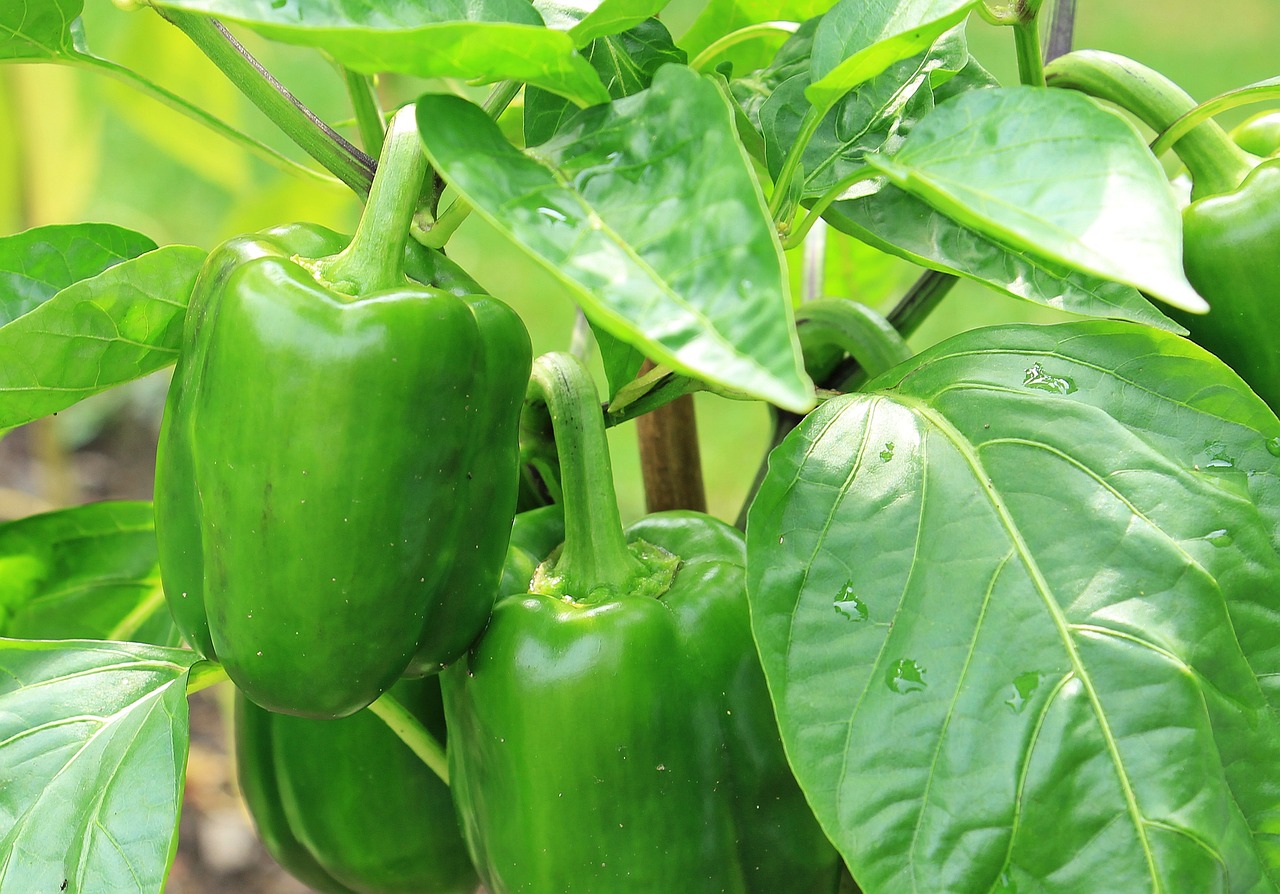
This post may have affiliate links. This means that sometimes when you click a link on our site and make a purchase on Amazon, we may earn a small commission at no additional cost to you. We only recommend products we truly believe in, and your support helps keep us running!
Green bell peppers, with their vibrant hues and crisp bite, are a summer garden staple. But did you know that their potential for flavor and abundance can be unlocked by the company they keep? Companion planting, the age-old technique of strategically positioning different plants for mutual benefit, can do wonders for your green pepper patch.
Intrigued? Buckle up, pepper enthusiast, as we explore 15 companions that will elevate your green pepper journey.
Nature’s Pest Control
- Basil: This fragrant herb not only repels pesky flies and mosquitoes with its essential oils, but also attracts beneficial hoverflies that prey on aphids, a common pepper nemesis. Plant basil intermittently amongst your pepper plants for a fragrant, pest-deterring duo.
- Marigolds: These cheerful blooms don’t just add a pop of color; their potent marigold scent deters whiteflies and thrips, notorious pepper munchers. Interplant them around the perimeter of your pepper bed for a colorful, protective barrier.
- Chives: This culinary herb doesn’t just add delicate oniony flavor to dishes; its strong scent repels aphids and other harmful insects. Plant chives in close proximity to your peppers for a flavorful, pest-repelling partnership.
Nutrient-Boosting Buddies
- Beans: These nitrogen-fixing legumes enrich the soil with essential nutrients, benefiting nearby pepper plants. Bush beans are particularly space-efficient companions, growing well beneath taller pepper plants.
- Peas: Similar to beans, peas act as nitrogen fixers, contributing to healthy pepper growth. Plant them early in the season, allowing them to provide support and nitrogen benefits as they climb up trellises alongside your peppers.
- Nasturtiums: These vibrant vining plants not only attract beneficial pollinators like bees and butterflies, but also act as “trap crops,” luring harmful insects away from your peppers. Let them sprawl around the base of your pepper plants for a colorful, pollinator-attracting, pest-distracting groundcover.
Flavorful Synergies
- Tomatoes: This classic combo isn’t just visually pleasing; both peppers and tomatoes share similar water and nutrient requirements, making them compatible neighbors. Just ensure they receive adequate sunlight and avoid overcrowding.
- Oregano: This aromatic herb, often used in pizza and pasta sauces, can surprisingly enhance the flavor of green peppers when planted nearby. Experiment with different oregano varieties to discover your favorite flavor combination.
- Dill: This feathery herb doesn’t just add a refreshing touch to pickles; its presence is said to improve the overall flavor and aroma of green peppers. Plant dill sparingly near your peppers for a subtle flavor boost.
Pollinator Powerhouses
- Borage: This stunning blue-flowered beauty attracts a multitude of pollinators like bees and butterflies, crucial for ensuring optimal fruit set in your pepper plants. Let its vibrant blooms add a touch of elegance and pollinator-attracting power to your garden.
- Sunflowers: These towering giants don’t just reach for the sky; their cheerful faces attract a swarm of beneficial insects, including pollinators that aid in pepper fruit development. Plant them at strategic intervals throughout your garden for maximum pollinator impact.
- Cosmos: These airy, daisy-like flowers come in a variety of colors and add a whimsical touch to the garden. But their true value lies in their ability to attract pollinators, leading to better pepper fruit set. Plant them in clusters near your pepper patch for a pollinator-friendly haven.
Additional Allies
- Lettuce: This leafy green thrives in the partial shade created by taller pepper plants, making them efficient space-utilizers. Lettuce also helps suppress weeds around pepper plants, creating a win-win situation.
- Marigolds (French varieties): While all marigolds deter pests, French marigolds have the added benefit of repelling harmful nematodes that can damage pepper roots. Plant them around the base of your pepper plants for added protection.
- Mint: While mint can be invasive, planting it in a confined container near your peppers can deter certain pests like ants and aphids. Just keep it contained to prevent it from taking over your garden.
Tips For Implementing Companion Planting In A Green Pepper Garden
1. Plan Your Garden Layout:
- Sketch out your garden layout, considering the space available and the sunlight exposure in different areas.
- Identify suitable companion plants based on their compatibility with green peppers and their pest-repelling or nutrient-enhancing properties.
2. Spacing and Planting Techniques:
- Space green pepper plants approximately 18-24 inches apart in rows, ensuring they have enough room to grow and receive adequate sunlight.
- Intersperse companion plants among the green pepper plants, alternating rows or grouping them strategically based on their growth habits and space requirements.
- Consider vertical gardening techniques for vine-like companions such as peas and beans, providing trellises or stakes for support.
3. Companion Plant Selection:
- Choose companion plants based on their beneficial effects on green peppers. For example, select basil and chives for pest control, beans and peas for soil enrichment, and marigolds for pest deterrence.
- Opt for companion plants that have similar water and sunlight requirements to ensure they thrive alongside green peppers.
4. Maintenance Considerations:
- Water all plants consistently, ensuring they receive sufficient moisture without becoming waterlogged.
- Mulch around the base of plants to retain moisture, suppress weeds, and regulate soil temperature.
- Monitor for signs of pests and diseases regularly, addressing issues promptly to prevent them from spreading to other plants.
- Provide support for taller companion plants if needed, such as staking tomatoes or trellising peas and beans.
- Prune companion plants as necessary to maintain airflow and prevent overcrowding, which can lead to disease development.
- Harvest ripe fruits and vegetables regularly to encourage continued production and prevent overcrowding in the garden.
